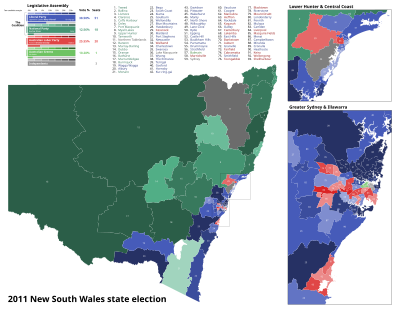| |||||||||||||||||||||||||||||||||||||||||||||||||||||||||||||
All 93 seats in the New South Wales Legislative Assembly and 21 (of the 42) seats in the New South Wales Legislative Council 47 Assembly seats were needed for a majority | |||||||||||||||||||||||||||||||||||||||||||||||||||||||||||||
|---|---|---|---|---|---|---|---|---|---|---|---|---|---|---|---|---|---|---|---|---|---|---|---|---|---|---|---|---|---|---|---|---|---|---|---|---|---|---|---|---|---|---|---|---|---|---|---|---|---|---|---|---|---|---|---|---|---|---|---|---|---|
| Opinion polls | |||||||||||||||||||||||||||||||||||||||||||||||||||||||||||||
| |||||||||||||||||||||||||||||||||||||||||||||||||||||||||||||
 Two-candidate-preferred margin by electorate | |||||||||||||||||||||||||||||||||||||||||||||||||||||||||||||
| |||||||||||||||||||||||||||||||||||||||||||||||||||||||||||||
The 2011 New South Wales state election held on Saturday, 26 March 2011. The 16-year-incumbent Labor Party government led by Premier Kristina Keneally was defeated in a landslide by the Liberal–National Coalition opposition led by Barry O'Farrell.
Labor suffered a two-party swing of 16.4 points, the largest against a sitting government at any level in Australia since World War II. From 50 seats at dissolution, Labor was knocked down to 20 seats—the worst defeat of a sitting government in New South Wales history, and one of the worst of a state government in Australia since federation. The Coalition picked up a 32-seat swing to win a strong majority, with 69 seats–the largest majority government, in terms of percentage of seats controlled, in NSW history. It is only the third time since 1941 that a NSW Labor government has been defeated. It was also notable in that many of Labor's safest seats, such as the seat of Newcastle, were won by the Liberal Party for the first time in history. This election also saw the previous record for largest percentage of seats defeated by the Coalition winning 74.2 percent of seats (69 out of 93 seats) with the previous record set by Neville Wran's Labor Party in the 1981 election, in which Labor won 69 out of 99 seats (69.7 percent).
New South Wales has compulsory voting, with an optional preferential ballot in single-member seats for the lower house and single transferable vote with optional preferential above-the-line voting in the proportionally represented upper house. The election was conducted by the New South Wales Electoral Commission (NSWEC).
Future premier Dominic Perrottet and future opposition leader Mark Speakman entered parliament at this election.



